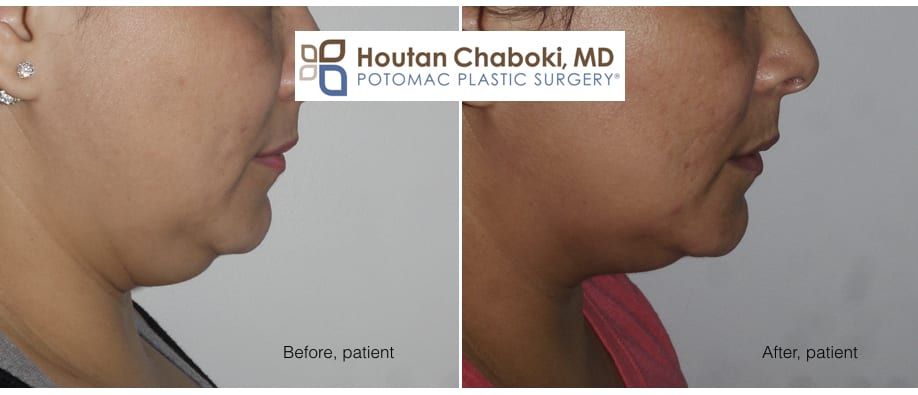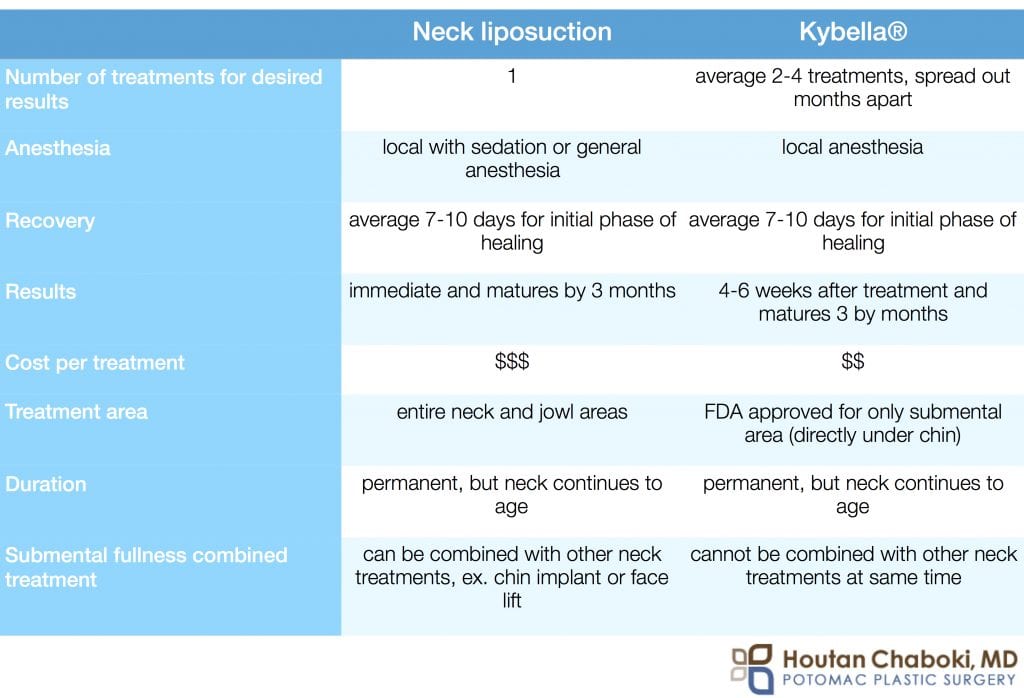
Before and after Kybella injections to improve a double chin. Neck fat reduction occurs gradually over time with nonsurgical options. This patient only received 2 Kybella treatments several months apart. After photograph is approximately two months from her second treatment. Additional Kybella treatments can further reduce neck fat as desired.
A double chin is a complaint of many Washington DC plastic surgery patients. Patients report fullness under the chin that is undesirable, and they want a more defined chin, neck, and jawline. With the rise of nonsurgical liquid lift treatments such as Botox® and facial fillers for the cheeks and eyes, patients often ask their plastic surgeon if nonsurgical procedures can improve a double chin too.
Reasons for a double chin
Excess neck fat is a main factor that leads to a double chin, also known as submental fullness. However, other anatomic components of the lower face and neck may contribute to the appearance of a “fat” neck including
- a small or weak chin bone
- sagging neck skin
- loose neck muscle (platysmal bands)
- droopy glands
A soft or double chin can be present from a young age, but also develops gradually with age. Neck fat is somewhat resistant to improvement with diet and exercise, while the other anatomic factors for a double chin don’t improve with lifestyle modification. Read more about double chin surgery in previous blog post.
Chin liposuction
Chin and neck liposuction is the traditional method to improve the cosmetic appearance of a fatty neck. Liposuction is a minor surgical procedure that works by immediate fat reduction of the superficial layer of neck fat, followed by some skin tightening that naturally occurs over the next few months. Skin tightening after liposuction is variable, but younger patients tend to tighten more as compared to older patients. Patients with significant skin laxity more likely need a lower facelift or neck lift surgery. Neck liposuction may be performed with a facelift, neck lift, or chin augmentation for enhanced results. Read more about chin and neck liposuction.
Nonsurgical neck fat reduction
Nonsurgical alternatives to liposuction are now available in plastic surgery offices. The makers of Botox have introduced Kybella®, a series of office injections that gradually reduces fat under the chin. Kybella® targets neck fat similar to liposuction. However, Kybella® is performed via multiple injections, spread apart over several months. Results develop gradually over time.
Liposuction vs. Kybella for neck fat
Neck liposuction may initially appear more expensive, but it has only one recovery period, can treat broader areas, and may be actually less expensive in the long-term. Patients may see improvement immediately with liposuction and continued skin tightening over time. In addition, neck liposuction can be combined with a chin implant and/or face lift for patients with a weak chin bone and/or sagging skin.
Kybella® cannot be combined at the same time with other neck treatments, and patients must be cautious if they have had any prior neck surgery. Kybella also requires at minimum two treatments months apart with a recovery period after each treatment. Patients with more neck fat will require more Kybella injections.
So, which treatment is better for neck fat?
As with many aspects of plastic surgery, there isn’t a “best” option. The decision regarding what is best for a patient is determined by multiple factors, including an individual’s neck anatomy and personal preference. Nonsurgical neck fat reduction with Kybella doesn’t replace neck liposuction for patients with submental fullness. However, Kybella may be appropriate for those patients with a small amount of isolated neck fat who don’t want surgery. Consultation with a cosmetic surgeon who specializes in the neck can help patients determine the specific cause(s) of their double chin and provide guidance regarding appropriate treatment options.
Considering treatment for a double chin or submental fullness? Contact the office to speak with a cosmetic surgery specialist.


Hi I am interested in getting these injections, what are the costs and where can I get this done?
Thank you for reading our blog!
Neck fat reduction with liposuction or injections like Kybella will vary in price based on multiple factors. Cost information on various procedures can be seen under our Resources page, https://www.potomacplasticsurgery.com/resources/financing-fees/
Best,
Dr. Chaboki